

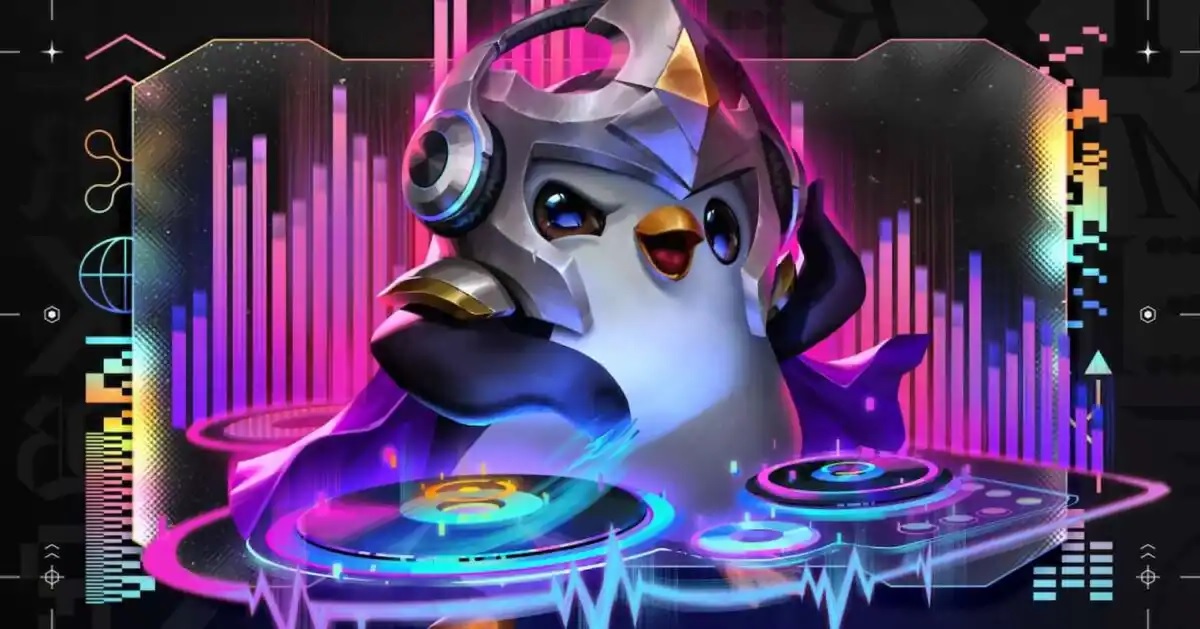
Teamfight Tactics Set Ten YouTube Videos Playlist
Set Ten was the long awaited music-based set which had been rumored for some time prior to its arrival. Set Ten was billed as a sort of "greatest hits" collection to commemorate the game reaching double digits on its set count. There was considerably more development time and attention put into this set as compared with Set Nine, and fortunately this paid off as there's a good case to be made that Set Ten was the best set of TFT to date. The developers brought back the Chosen mechanic from Set Four, now renamed as "Headliners" with a few minor tweaks to their mechanics, then combined them together with the augments and portals added in recent sets for a new mixture that really did feel like grabbing the best individual elements from the prior four years of TFT's history. In this retrospective writeup, we'll take a look at what Set Ten did well along with the few areas where it came up short before wrapping things up with a few concluding thoughts.

First and foremost, the best thing that Set Ten did was bring back the Chosen mechanic in the form of Headliners. As a refresher on Chosen/Headliner units, these were two star versions of the same units that appeared in the shop with additional stats above and beyond the norm. To stop the game from being a race to collect as many of these units as possible, each player would only be able to have one Headliner unit on their team at a time. New to Set Ten was a less punishing rule where Headliners would always show up in the store if there wasn't one on the player's team, and would appear once every four shops if there was one present. The whole concept was therefore both extremely simple and also full of interesting strategic decisions for the player to make. Should you play a Headliner that appears in the store even if it isn't a great fit for the current team composition, or consider pivoting into an entirely different setup to utilize a tasty Headliner? How long should the player hold onto an early game Headliner versus selling it and searching for a more expensive and powerful lategame Headliner? Furthermore, Headliner units also counted for two versions of one of their traits in the same fashion that Lux had counted for two versions of an elemental trait in Set Two. This created an immense amount of replayability on top of all the other good things added by this mechanic as every game the player would be given different Headliner options and the opportunity to play different team compositions. The mechanic was easy to understand and had a lot of depth, making it highly popular with players and reviving the popularity of Set Four where the concept had originated.
I've been on record for a long time now with the opinion that this is still the best mechanic that the developers have ever created for Teamfight Tactics. The Headliner units provide a natural direction for players to take their team composition while also enormously emphasizing flexible gameplay. Those players who try to force the same thing game after game in rote repetition will never do as well under this system as those who are playing around the Headliner units that they hit and pivoting accordingly. Even antisocialmunky, who famously forced hundreds upon hundreds of games of Kayle and Tristana reroll in past sets, found himself alternating between several different reroll builds in Set Ten due to the need to work around the Headliner units offered. In fact, the positive effects on TFT's gameplay from the Headliner mechanic are so numerous the biggest question has to be, why did the developer wait so long to bring this system back? Why did we have to wait three years and six full sets to see it return? I hope they don't wait as long again in the future because this is such a clear winner and far superior to nonsense like shadow items and dragon units.

It was also clear that Set Ten benefited from its additional development time by having a series of novel unit and trait designs as opposed to the reprints that often plagued past sets. This was most noticeable in the more expensive four and five cost units which featured abilities like Zac's bouncing, Poppy's hammer-smashing, Jhin placing turrets on the bench, three different selectable abilities on Sona (even if only one of them was any good for most of the set), and tentacle/ghoul spam from Illaoi and Yorick respectively. There were a lot of new traits in this set that we hadn't seen before and proved to have interesting gameplay, things like the EDM units "sampling" one another's abilities and 8-Bit stacking up to a high score that could lead to an infinite gold jackpot cashout. I thought that the Superfan trait had a well-designed interaction with the Headliner mechanic, even if these units were a bit overtuned for most of the set, and Punk was maybe the best-designed reroll trait ever with clear strengths and weaknesses to play around.
If I had to single out two traits as examples of excellent design, they would be Jazz and Heartsteel. The Jazz trait simply brought the old Stand United augment directly into the trait design, rewarding players for running as many active traits as possible (though sadly excluding unique traits from the Legendary units). This was almost always worth splashing onto a lategame board and was even more powerful at the set's release before eating a bunch of nerfs. Heartsteel is in the running with Underground as the best economic trait in TFT's history, a trait that provided more benefits from losing rounds while still being completely playable while win-streaking. The best part about Heartsteel was the way that the "hearts" that it produced for cashouts were scaled towards the lategame; in other words, losing rounds with Heartsteel on Stage 5 were worth way more hearts than losing rounds on Stage 2. This was an absolutely perfect way to work around the Fortune/Piltover phenomenon of "lose the first 10 rounds of the game and then cash out and become invincible" because the early rounds don't cost as much health. Sadly this was undermined a bit by adding a "Raise the Stakes" mechanic halfway through the set that incentivized loss streaking but Heartsteel still remained a strong trait regardless. If anything, it was a little too good for way too long as it often felt that Heartsteel players would win every lobby because other team compositions couldn't keep up with their bonus econ.
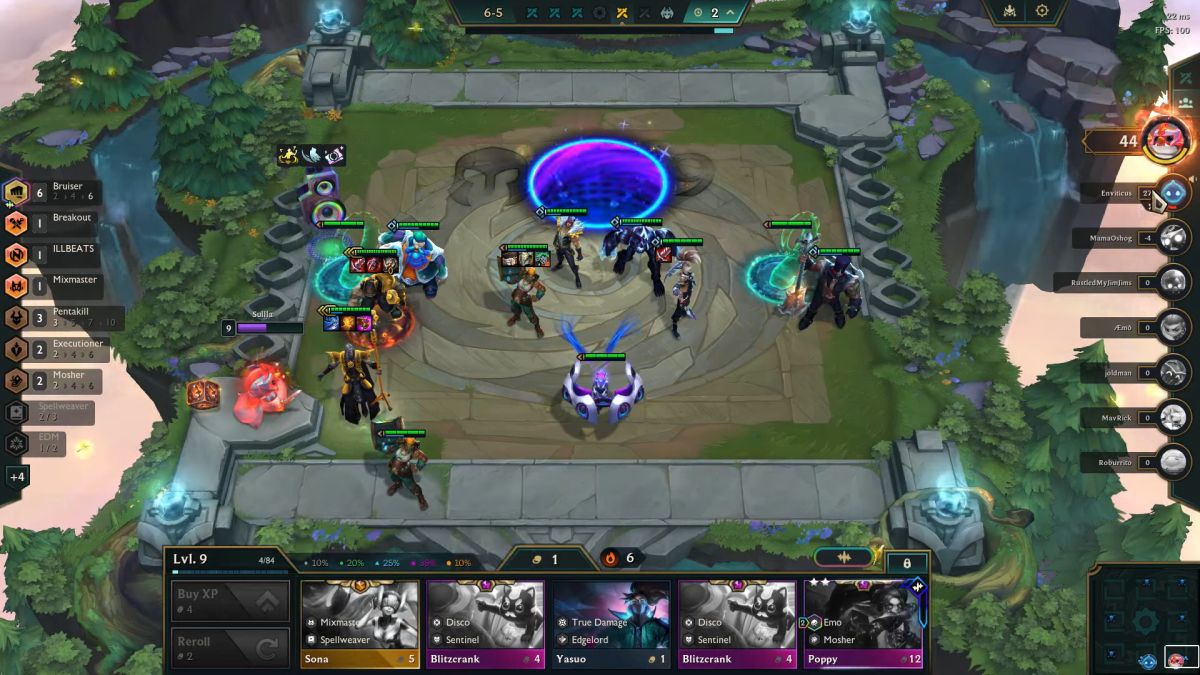
One of the truisms of these past TFT retrospectives has involved detailing the embarassingly poor gameplay balance as the developers buffed and nerfed units/traits with reckless abandon, leading to the wild swings that we know as balance thrashing. This idiocy that has bedeviled TFT for years... basically didn't happen in Set Ten!  Incredibly, the developers largely left the gameplay alone and released almost nothing in terms of "B" patches or emergency hotfixes. When combined together with the long winter holiday break, five weeks when the developers were locked out of releasing any patches at all, it made for remarkable stability in Set Ten's gameplay. Of course, this was only possible because the set was largely in good shape from a balance perspective throughout its history. That's not to say that everything was perfect, however by and large there were a lot of playable team compositions in every patch. Set Ten did not have anything like the Multicaster patch in Set 9.5 where four people were playing Multicasters per lobby and still averaging a 3.80 finish. Even the augment balace was better with almost nothing ever dropping below 4.00 average finish or rising above 5.00. Needless to say, previous sets were nowhere near as clean as this and often turned into downright trainwrecks.
Incredibly, the developers largely left the gameplay alone and released almost nothing in terms of "B" patches or emergency hotfixes. When combined together with the long winter holiday break, five weeks when the developers were locked out of releasing any patches at all, it made for remarkable stability in Set Ten's gameplay. Of course, this was only possible because the set was largely in good shape from a balance perspective throughout its history. That's not to say that everything was perfect, however by and large there were a lot of playable team compositions in every patch. Set Ten did not have anything like the Multicaster patch in Set 9.5 where four people were playing Multicasters per lobby and still averaging a 3.80 finish. Even the augment balace was better with almost nothing ever dropping below 4.00 average finish or rising above 5.00. Needless to say, previous sets were nowhere near as clean as this and often turned into downright trainwrecks.
It wasn't just the developers taking a hands-off approach that worked to Set Ten's advantage, however. The developers also deserve credit for making changes to the gameplay under the hood which provided a self-regulating mechanism and kept everything running smoothly. The most important of these were the changes to the "bag size", i.e. how many units of each type were present for players to find in the shop. These numbers had been stable for a long time before Set Ten, with 29 copies of each 1 cost unit, 22 copies of each 2 cost unit, and so on with total numbers sitting at 29/22/18/12/10 across the five cost tiers. Set Ten decreased the number of units available at each cost tier down to the following amounts: 22/20/17/10/9. This meant fewer copies of the same unit available for everyone to draw out of the overall pool as there were only 10 copies of Ezreal to find as opposed to 12 copies as there would have been in earlier sets.
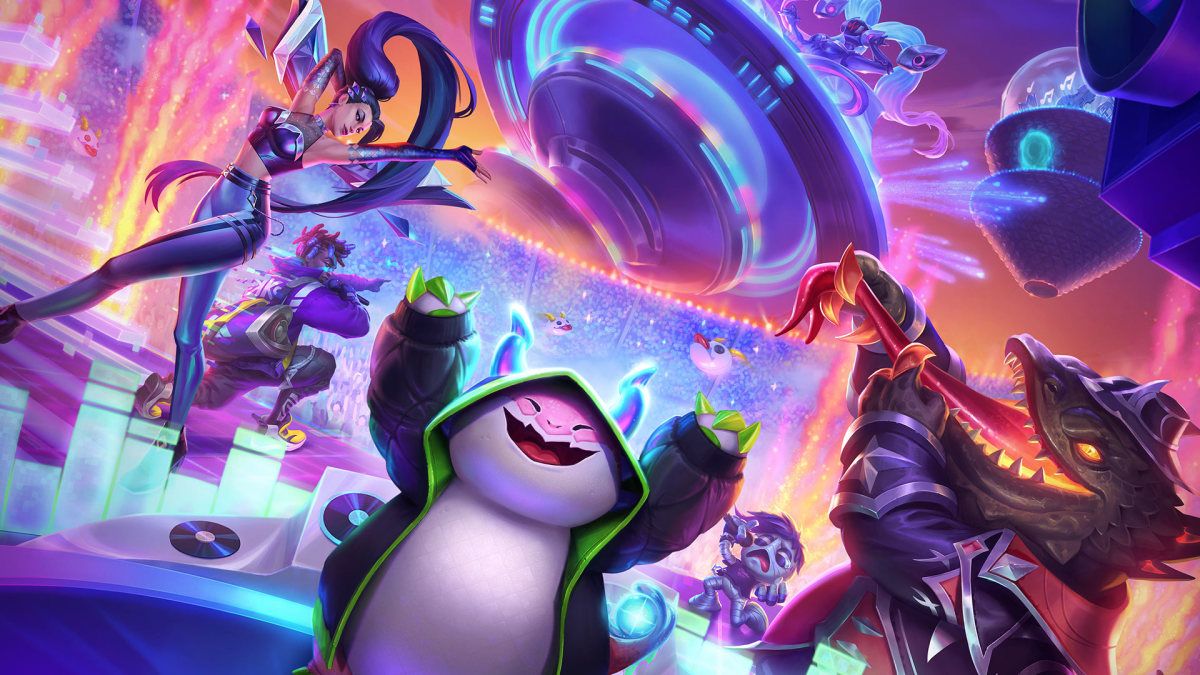
While this might sound like an esoteric piece of game design, these changes to the TFT bag size were a major reason why Set Ten's balance was so much better than its predecessors. In a nutshell, these changes made it much more difficult for multiple players to contest each other for the same units. There simply weren't enough of the champions to go around anymore, greatly incentivizing players to try and run something uncontested as opposed to being the fourth person in the lobby also playing KDA. This also synergized perfectly with the Headliner mechanic as players would constantly find opportunities to pivot in a new direction as 2 star units appeared in the shop ready for purchase. Even when a particular trait or unit happened to be overpowered in an individual patch, it tended to avoid breaking the gameplay because there weren't enough units for more than one or two people to play simultaneously. It was REALLY noticeable how much harder it was to reroll for Punk units if two people were trying to play the comp and a 3 cost reroll setup like Country tended to grief everyone if played by multiple individuals (since there were only 17 Samiras and Urgots in the bag - not enough for two people to 3 star both units). This was an absolutely brilliant mechanics change and I was glad to hear that the smaller bag sizes would be sticking around for Set Eleven.
The other big change to the gameplay was a strict limitation on getting spatulas, emblems, and Tome of Traits in Set Ten. The developers removed all of the augments that added +1 to traits or provided spatulas/emblems/Tomes, with the intention that players would have to rely on getting +1 to traits from their Headliner units instead of items. When spatulas did appear on item carousels, they were extremely hot commodities which were usually snapped up immediately. This was again fantastic for gameplay purposes as so many of the gameplay problems from past TFT sets have been caused by traits appearing on units that don't normally have them. I also thought it was great to have spatulas and emblems as genuinely rare prizes, the kind of thing that wouldn't show up very often and should be valued accordingly when they did appear. This was infinitely better than the URF meta at the end of Set 9 where Tome of Traits were raining from the sky and everyone was trying to get double or triple emblems to play Demacia 9 or whatever. The only small problem was that the Double Up gift rounds continued to give out spatulas at way too high of a rate, making it far too easy to hit the chase traits like Pentakill 10 in the two-player mode. At least this was finally fixed at the tail end of the set and the gameplay benefited right away from the correction of this oversight.
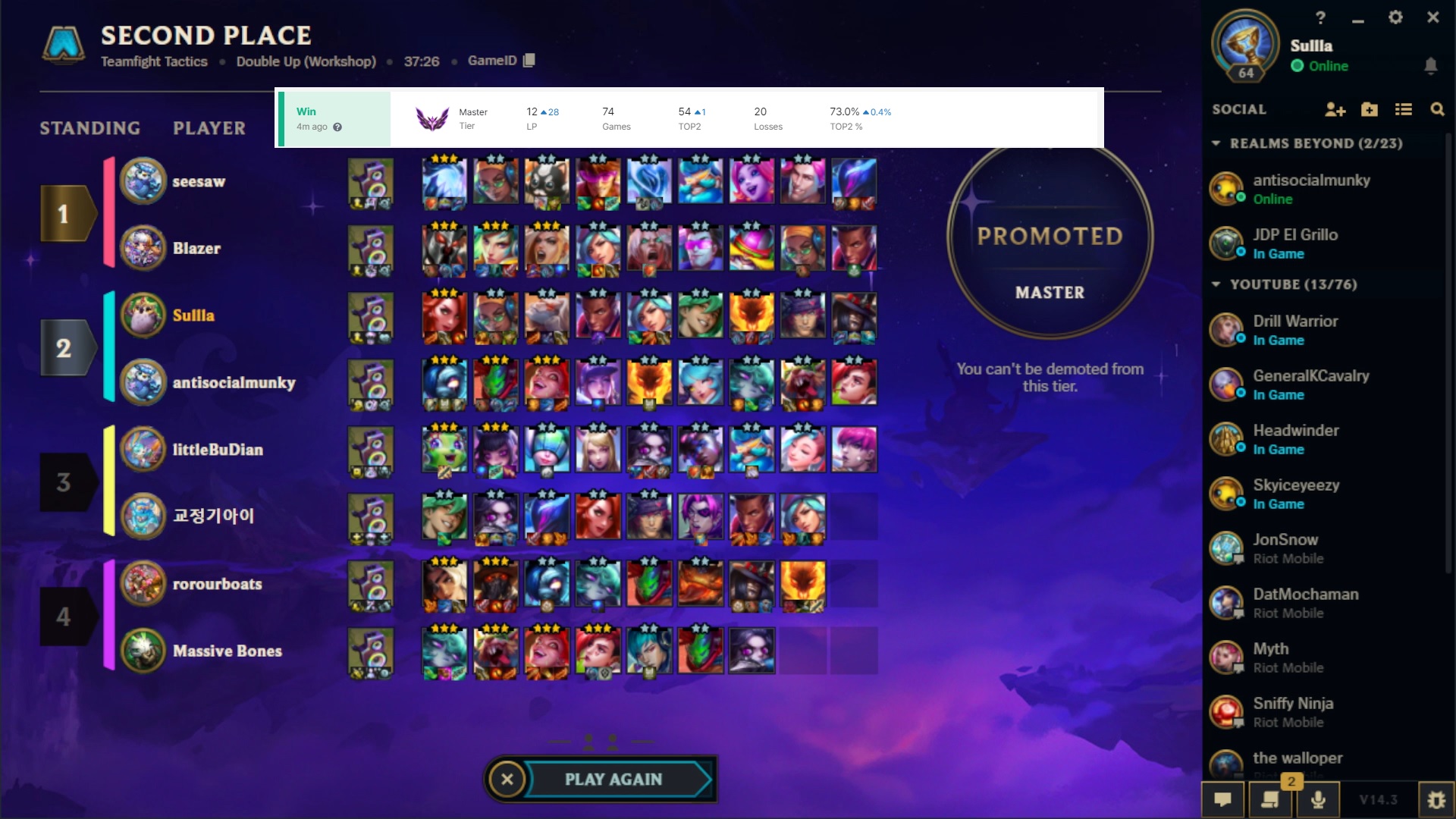
Speaking of Double Up mode, one sign that this was an enjoyable set was how many games I was willing to play with friends. I ended up running about 80 Double Up games in all, eventually reaching Masters tier by the end of the set thanks to the help of antisocialmunky, JDP El Grillo, and headwinder. This was the highest rating that I'd ever earned in TFT (roughly the top 0.5% of the playerbase) and it felt like a genuinely meaningful recognition of the time that I devoted to this game over the years. I'm confident that I could have made it to Masters tier in previous sets but they simply weren't fun enough to grind out the required games. It's not a coincidence that the sets I've enjoyed the most have also been the ones where I played the most games.
Finally, I should also mention that Set Ten was the first set since Set Two that didn't have a midset update. This was another improvement as the TFT community didn't have to spend the next three months stuck with a half-assed midset update where the various pieces didn't fit together properly while the developers worked on the next real set. I always felt that the midset update arrived too quickly after 90 days while the wait for the next full set took too long at a full six months. Dropping the midset updates and swapping over to a four month release schedule felt vastly better as I was just about ready to be finished with Set Ten when Set Eleven popped up on the PBE. And, even though it didn't affect the gameplay itself, I have to credit Set Ten for having dynamic music in the background that changed based on which units were being fielded. That was such a cool idea and the development team did an impressive job at pulling it off smoothly. 

This has been a pretty glowing review thus far but we do need to cover the various shortcomings of Set Ten as well. For the most part these were pretty minor as the set was in such good shape overall. The first and foremost issue was a lack of clarity regarding how the Headliner units appeared in the shop. Everyone knew the three basic rules: only one Headliner can be owned at a time, Headliners appear in every shop when the player doesn't have one, every four shops when they do. However, there were a bunch of other rules operating in secret, designed to smooth out some of the randomness of the system, which had a real effect on the gameplay. These rules included: the same champion won't appear as a Headliner again for 7 more shops, the same trait won't appear as the doubled Headliner effect for the next 4 shops, the next time that a champion appears as a Headliner they will have a different trait as the doubled trait, and so on. Again, it was good having these additional rules in place to avoid RNG frustration; imagine having Gnar pop up as a Headliner in three of the next four shops, that would be incredibly annoying.
But the problem was that all of this information was hidden from players! The TFT developers should have stated all of these unspoken rules in the initial patch notes, which would have been ignored by 90% of the players while being useful to the cutthroat 10% remainder. Instead, they left all of this stuff shrouded in mystery where it was worked out through trial-and-error experimentation by enterprizing players. There was even another rule where players could get around these "lockout" mechanics by buying and then immediately selling a Headliner, which was really bad for gameplay purposes as it gave a legitimate advantage to those who knew the hidden rules. Eventually this was patched out and the rules explained by the developers, but again only in a Reddit post which, come on, really? This should have been acknowledged from the start and included in the actual client. So while the Headliner mechanic itself was great and having extra rules to smooth out randomness were a good idea, the developers dropped the ball on explaining what was really going on.
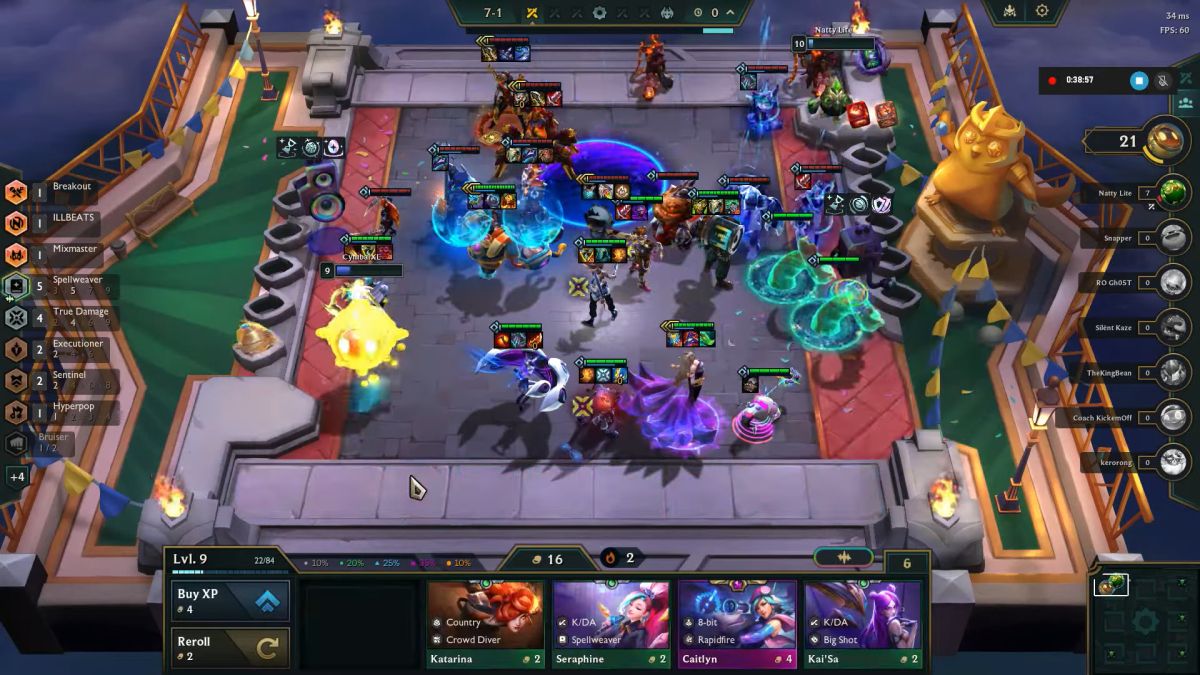
Another weakness in the gameplay was the initial starting Portals which were carried over from Set Nine. Some of these Portals had modest effects like granting a 3 cost champion to start the game or giving everyone a support item to play around. Others had game-breakingly powerful effects, like transforming all of the augments into Prismatic or dropping truly massive amounts of loot from effects like Scuttle Puddle or Crab Rave. The Portals also became worse over time as the developers removed some of the balanced, low-effect Portals and replaced them with slot machine garbage like Champion Delivery that handed out random 4 and 5 cost units like they were candy or Wandering Trainers and its targeting dummy with three random emblems. It was enormously frustrating to watch as the developers put in the work to balance a mechanic and then deliberately unbalanced it via later patches with free loot to titillate the masses.
Making matters even more annoying was the fact that the developers weren't even wrong to do this: the much unbalanced, slot-machine nonsense Portals also proved to be the most popular Portals!  We had seen this back in Set Nine as well and it was depressing to watch six players race over to whatever Portal handed out the most junk in lobby after lobby. It's clear by now that a large percentage of the TFT playerbase does *NOT* in fact want balanced gameplay, they want to open those loot boxes and chase after the toughest to reach traits like Heartsteel 10. Whatever gives them the most emblems, the most spatulas, the most champion duplicators, that's what the bulk of the community is going to pick. This is genuinely saddening to me because it's eminently clear that the TFT development team is not being rewarded for creating balanced gameplay. In fact, they were likely penalized for doing so as Set Ten was apparently not very popular in China specifically because it had stripped out so many of the gambling elements in favor of balancing the gameplay. This was why the developers added the "Raise the Stakes" concept for Heartsteel and brought back some of the most loot-focused Portals from Set Nine: because most of TFT's playerbase is in East Asia and that's what they wanted in the gameplay. I also suspect that Heartsteel was deliberately left overtuned for such a long time because the developers knew that this was the cash-out trait that so many of those players wanted to run every game.
We had seen this back in Set Nine as well and it was depressing to watch six players race over to whatever Portal handed out the most junk in lobby after lobby. It's clear by now that a large percentage of the TFT playerbase does *NOT* in fact want balanced gameplay, they want to open those loot boxes and chase after the toughest to reach traits like Heartsteel 10. Whatever gives them the most emblems, the most spatulas, the most champion duplicators, that's what the bulk of the community is going to pick. This is genuinely saddening to me because it's eminently clear that the TFT development team is not being rewarded for creating balanced gameplay. In fact, they were likely penalized for doing so as Set Ten was apparently not very popular in China specifically because it had stripped out so many of the gambling elements in favor of balancing the gameplay. This was why the developers added the "Raise the Stakes" concept for Heartsteel and brought back some of the most loot-focused Portals from Set Nine: because most of TFT's playerbase is in East Asia and that's what they wanted in the gameplay. I also suspect that Heartsteel was deliberately left overtuned for such a long time because the developers knew that this was the cash-out trait that so many of those players wanted to run every game.
We're therefore left with an unsettling conclusion: it's most likely not in the interests of the TFT development team to deliver a balanced gameplay experience. The financial and gameplay incentives are running in opposite directions and Riot Games almost certainly will make more money from keeping TFT full of luck-based, loot box elements. The Fortune trait announced for Set Eleven is a clear step in this direction which promises to be much less balaced than Heartsteel and practically seems designed around luring people with a gambling habit. I'm reminded again of the Civ4 vs Civ5 situation where Civ4 spent an enormous amount of time working on carefully tuning the gameplay balace and Civ5 just... didn't, then sold far more copies because it showered the player with free loot at every turn. I'm hoping that Set Ten wasn't an aberration in terms of the gameplay being so balanced, but the financial incentives to lean into the gamba side of things are so strong that I'm not too optimistic for the future. I guess we'll see.
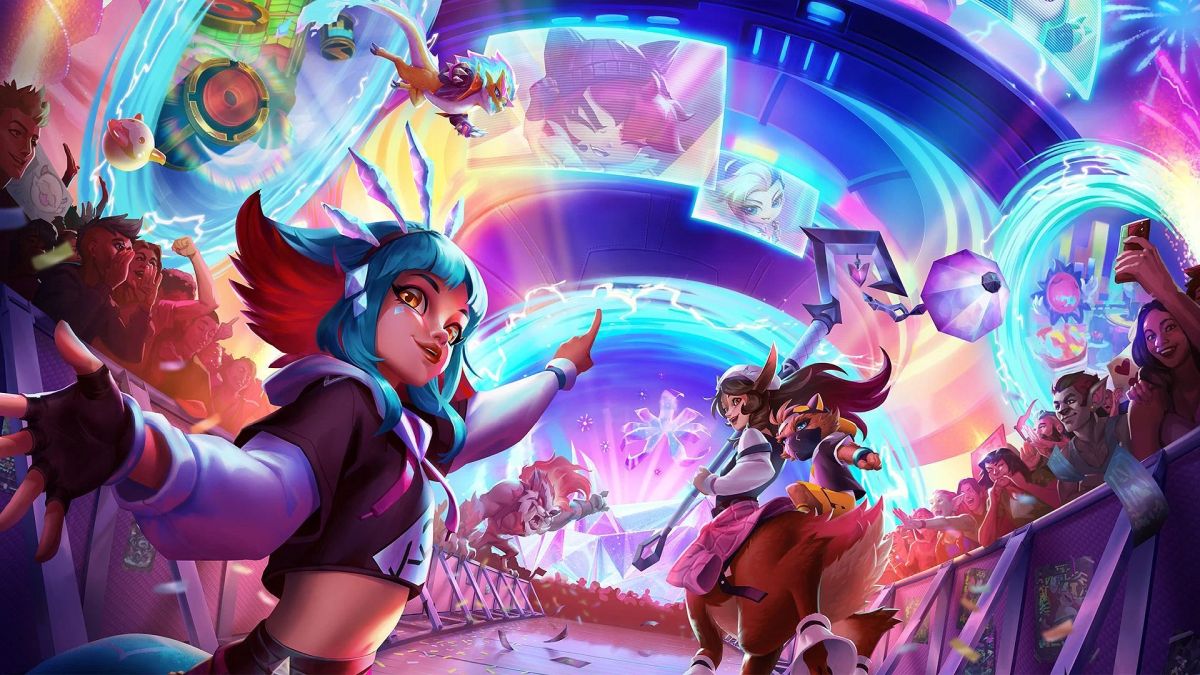
Was Set Ten the best set ever of Teamfight Tactics? I think it's a fair question to ask and the set was good enough to pose a real debate. I think it comes down to whether one chooses to prioritize the greater polish, superior gameplay balance, and collection of the best features of previous sets in Set Ten against a lack of any truly new features like augments, portals, or Chosen/Headliner units. For me, I think it's a tossup as to whether Set Ten or the first half of Set Six grades out better, with both of them providing a truly excellent gaming experience. If TFT were always this fun, we'd have a lot less to complain about.
I don't plan on writing any more of these retrospective articles for TFT on the website (though I'll probably still record a video since those are a lot easier to put together). I've done enough of these by now that there's really nothing more to say: the developers can absolutely balance TFT's gameplay, and Set Ten proved that it doesn't take a half dozen patches to reach that point, they can get there right away if they want to. However, there are a ton of financial incentives for them *NOT* to balance the gameplay, and that's why we live in the perpetual balance thrashing mode most of the time. TFT is still a great game, most of the time anyway, and we always get that blissful month every year in December when the developers are physically barred from patching the game which forces it into a period of stability. I know that I'll be looking forward to it later this year when it rolls around again in Set Twelve or Thirteen. Thanks as always for reading along!



